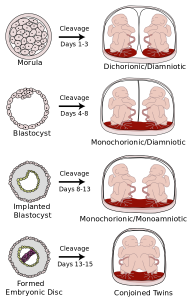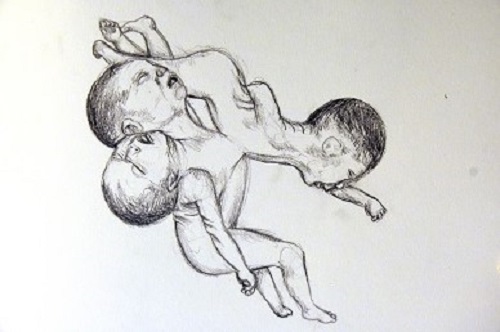Of course, we all know that conjoined twins are possible, but what about conjoined triplets? That’s a great question. Has there ever been a confirmed case in all of history? After thorough research, we gathered some useful information to help answer this question.
If you go to Google and type in “conjoined triplets,” you won’t exactly find what you are looking for. You mostly see articles about identical triplets, with two that are conjoined. What we want to know is whether there has been a case where all 3 identical triplets are conjoined.
Featured-image sketch by Desiree Walker.
Here’s what we found:
Has there ever been conjoined triplets?
Yes. At 22 weeks of gestation, a prenatal diagnosis was made using 2-dimensional ultrasonography and magnetic resonance imaging. It was confirmed (postnatal) to be the first and only known case of human conjoined triplets.
A hysterotomy was performed to terminate the pregnancy.
Source: American Journal of Obstetrics and Gynecology (peer-reviewed journal)
Three pictures of this unique case.
Has there ever been a case of conjoined triplets in animals?
There has never been a confirmed live birth of human conjoined triplets. However, sources like Quora.com say Ripley’s Believe It or Not! claims that there is one recorded case of conjoined pig triplets. The piglets survived for only a few minutes.
The chances of having conjoined twins

“Placentation” by Kevin Dufendach is licensed under CC BY 3.0
The above image shows various types of chorionicity and amniosity (how the baby’s sac looks) in identical twins as a result of when the fertilized egg divides. Conjoined twins are so rare, they will only occur once in every 200,000 live births. However, identical triplets are even more rare.
The rarity of identical triplets

Although most triplets are trizygotic (when each child has formed from a separate egg/sperm combination), it is not that unusual for them to also be dizygotic (when two eggs are fertilized by sperm, and one of the fertilized eggs splits into two). Two of the triplets will be identical (sharing general DNA characteristics), but the third will have a unique genetic heritage. This is commonly referred to as “a pair and a spare”, which means that two are identical, and one is fraternal.
Monozygotic Triplets: How They Occur
So how is it possible for triplets to be completely monozygotic (identical)?
1. A single egg splits three ways.
2. A single egg splits into two. Then, one of the two eggs split again.
Did you know that some monozygotic triplets are actually quadruplets? You may be wondering how this is even possible. This occurs when an embryo has either vanished or been reabsorbed.
What are the chances of having conjoined triplets?
Before we go any further, it is important we mention that conjoined siblings will occur only in monozygotic multiples (identical twins). So in order for there to actually be conjoined triplets, all three children must be identical. Plus, of course, all three children must also be conjoined.
We had previously mentioned the odds of having identical triplets (between one in 60,000 to one in 200 million pregnancies), and conjoined twins (once in every 200,000 live births). You can surely see just how unlikely it is for all three children to not just be identical, but also conjoined. With such low odds of both occurring together, you know exactly why you just don’t hear about these types of cases. Now we are going to talk about some unconfirmed cases we found from online sources.
Some unconfirmed cases
The following are unconfirmed cases of conjoined triplets. Each case was found on Askville.
Case #1
A case of three unidentified boys in Sicily, Italy, 1834. The boys were born with a single torso, two hearts, two stomachs, two lungs, and three heads. According to the source, the case was profiled in Gould & Pyle’s Curiosities of Medicine.
Case #2
In Samsun, Turkey, 1955, there was a case where the children had three heads, two pairs of arms, and two pairs of legs. Sadly, they only lived for two hours. Amazingly, the autopsy found four lungs, three livers, three brains, two kidneys, and two hearts. In 1955, the unbelievable story had appeared in Sexology Magazine. For the information, they cited the Journal of the American Medical Association.
Conjoined Quadruplets
The article on Askville also states that regardless of the immensity low odds, there has been one case of conjoined quadruplets. In Norway, September 5, 1953, two of the four babies were conjoined, but had died at birth.
A Case Of Rare Identical Triplets, Two Are Conjoined
In May of 2015, a Texas woman gave birth to identical triplet girls. Though identical triplets are unusual, what’s even more odd is that two of the babies are joined at the pelvis. Although they have separate legs and separate bladders, part of their intestines and abdominal wall are attached.
The babies were born at approximately 34 weeks. They all weigh 4 lbs., 11 oz. According to Raul Torres (the father of the triplets), the babies will likely be separated within six months to a year.
This particular case is what you mostly see when you search for “conjoined triplets” on Google. So is this as close as it gets? Instead of there being all three triplets conjoined, it looks like one of the very few confirmed cases that is closest to it, is this one. Identical triplets? Yes, but only 2 that are conjoined. Of course, in the future, there may be a confirmed case where all 3 are conjoined.
This post was updated on 2/17/2019. For an article with information on conjoined twins from nearly the last 1,000 years of history, visit Conjoined Twins: Then And Now.
Fortunately for patients who suffer with a rare and serious medical condition (like the amazing story previously mentioned), advances in medical technology has helped increase their chances of surviving. Conjoined twins are able to live a lot longer these days.
Perhaps one day there will be a case of human conjoined triplets who make it to birth and beyond. Until then, all we can do is speculate on the details of the first case ever recorded.



